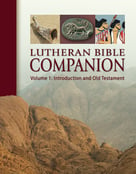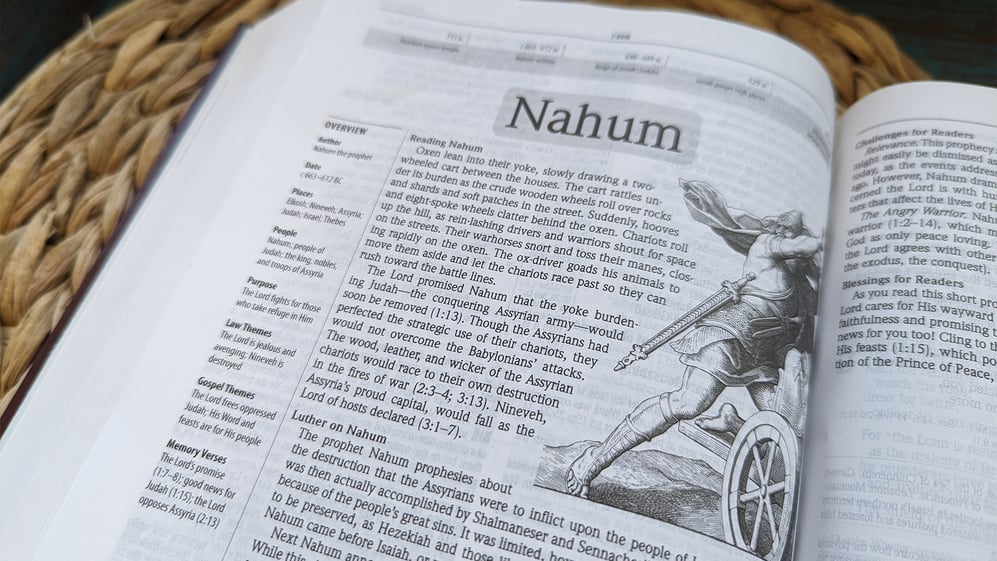Nahum is a book of comfort for those who trust in the LORD. God is portrayed as a warrior who will fight for His people, but He is also as an avenging God who does not tolerate wickedness. The following is adapted from Lutheran Bible Companion.
The LORD is good, a stronghold in the day of trouble; He knows those who take refuge in Him. But with an overflowing flood He will make a complete end of the adversaries, and will pursue His enemies into darkness. (Nahum 1:7–8)
Historical and Cultural Setting
Nineveh, the capital city of the Assyrian Empire, was a powerful and great city. It was established by Sennacherib (704–681 BC) on the east bank of the Tigris River. Its location on an important trade highway between the Mediterranean Sea and the Persian Gulf made it known as the greatest of all ancient cities (cf Jnh 3:3).
As Nahum wrote, the Assyrian Empire reached the height of its power, bypassing tiny Judah for the greater glory of conquering and occupying Egypt. However, the Assyrians’ dominance would not last long. In c 664 Psamtik expelled the Assyrian troops from Egypt. By c 612–609 the Neo-Babylonian Empire had overrun Assyria in keeping with Nahum’s prophecy of Nineveh’s destruction.
Purpose/Recipients
This short book communicates a message of comfort to God’s people in
Judah: that the dreaded Assyrian Empire is about to come to an end. For the
people of Nineveh, the capital city of Assyria, Nahum’s warning of impending destruction should have brought them to repentance. But they did not repent, and Nineveh was destroyed.
Literary Features
Stylistically, Nahum easily heads the list of the Minor Prophets. Many of his deft, vivid, word-pictures are fully worthy of Isaiah, who is regarded as the best of all “writing prophets.” Some of Nahum’s forcefulness is evident even in translation, but much is inevitably also lost. Nahum has been called the last of the great classical Hebrew poets, and it has been observed that his rhythm “rumbles and rolls, leaps and flashes, like the horsemen and chariots that he describes.” Similar praises could easily be multiplied. Readers who wish to capture the literary strength of the book may wish to read it aloud from start to finish.
Summary Commentary
Chapter 1
Nahum foretells God’s swift and final destruction of Nineveh and the Assyrian Empire. With mighty power, God executes His avenging wrath against His adversaries, who plot evil against Him and His people. The Lord, who is “a jealous and avenging God” (v 2), demands exclusive devotion (Ex 34:14; Dt 4:24).
Chapter 2
Nahum mockingly describes the sudden, devastating siege and capture of Nineveh, the city once known for its ruthlessness and cruelty.
Chapter 3
For Nineveh, God’s patience came to an end. The evil nation of Assyria that had tyrannized surrounding peoples, acquiring wealth and power at their expense, was overthrown, and it disappeared from the annals of history. God’s wrath is revealed against all unrighteousness (Rm 1:18).
Specific Doctrines
Nahum emphasizes the justice and universality of God’s action in world history. He concentrates on the application of that justice to a major scourge of God’s people (as most other prophets do). Assyria did God’s will by punishing Israel for its sins, but the Assyrians deserved God’s judgment themselves. Biblical theology reminds us that the judgment on Nineveh becomes part of our history. God also judges our imperiousness. The dominant teaching in Nahum has to do with God’s wrath, tempered with promises of comfort and protection for God’s people (1:6–7). In this way, the book defines the “good news” (1:15), the Old Testament expression translated as “Gospel” in the New Testament.
Blog post adapted from Lutheran Bible Companion, vol. 1: Introduction and Old Testament, pages 935–41, © 2014. Concordia Publishing House. All rights reserved.
Scripture: ESV®.
 Learn more about Nahum in Lutheran Bible Companion.
Learn more about Nahum in Lutheran Bible Companion.











